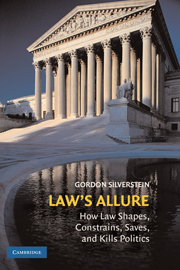Book contents
- Frontmatter
- Contents
- Acknowledgments
- LAW'S ALLURE
- Introduction: Law's Allure: The Juridification of American Politics and Public Policy
- PART I LAW'S ALLURE: WHY, WHY NOW, AND WHY IT MATTERS
- PART II LAW'S ALLURE: PATTERNS, PROCESS, AND CAUTIONARY TALES
- PART III LAW'S ALLURE: COSTS AND CONSEQUENCES
- Conclusion: The Promise and Peril of Law's Allure
- Bibliography
- Index
- References
Conclusion: The Promise and Peril of Law's Allure
Published online by Cambridge University Press: 05 June 2012
- Frontmatter
- Contents
- Acknowledgments
- LAW'S ALLURE
- Introduction: Law's Allure: The Juridification of American Politics and Public Policy
- PART I LAW'S ALLURE: WHY, WHY NOW, AND WHY IT MATTERS
- PART II LAW'S ALLURE: PATTERNS, PROCESS, AND CAUTIONARY TALES
- PART III LAW'S ALLURE: COSTS AND CONSEQUENCES
- Conclusion: The Promise and Peril of Law's Allure
- Bibliography
- Index
- References
Summary
The american system is fragmented and divided – intentionally. The constitutional system drawn up in a stuffy, hot, crowded Philadelphia meeting hall in the summer of 1787 was designed to make change possible, but very difficult. The great challenge was to find a way to make the government efficient, to make it strong enough “to control the governed,” and yet make sure that it could not become tyrannical. To accomplish both of these goals, power in America was divided and then divided and divided again. “In the compound republic of America,” James Madison wrote in the Federalist Papers, “power surrendered by the people is first divided between two distinct governments” – the national government and the state government – “and then the portion allotted to each subdivided among distinct and separate departments.” This would provide a “double security” Madison wrote: “The different governments will control each other, at the same time that each will be controlled by itself.”
This is not a prescription for efficiency. As Justice Brandeis noted in 1926, the purpose of the separation of powers “was, not to avoid friction, but, by means of the inevitable friction incident to the distribution of the governmental powers among three departments, to save the people from autocracy.” The American government is not designed to respond nimbly to crisis and change. It is a government that is capable of that response, but not easily. To work within the political system is slow and often frustrating – and sometimes futile.
- Type
- Chapter
- Information
- Law's AllureHow Law Shapes, Constrains, Saves, and Kills Politics, pp. 266 - 286Publisher: Cambridge University PressPrint publication year: 2009



